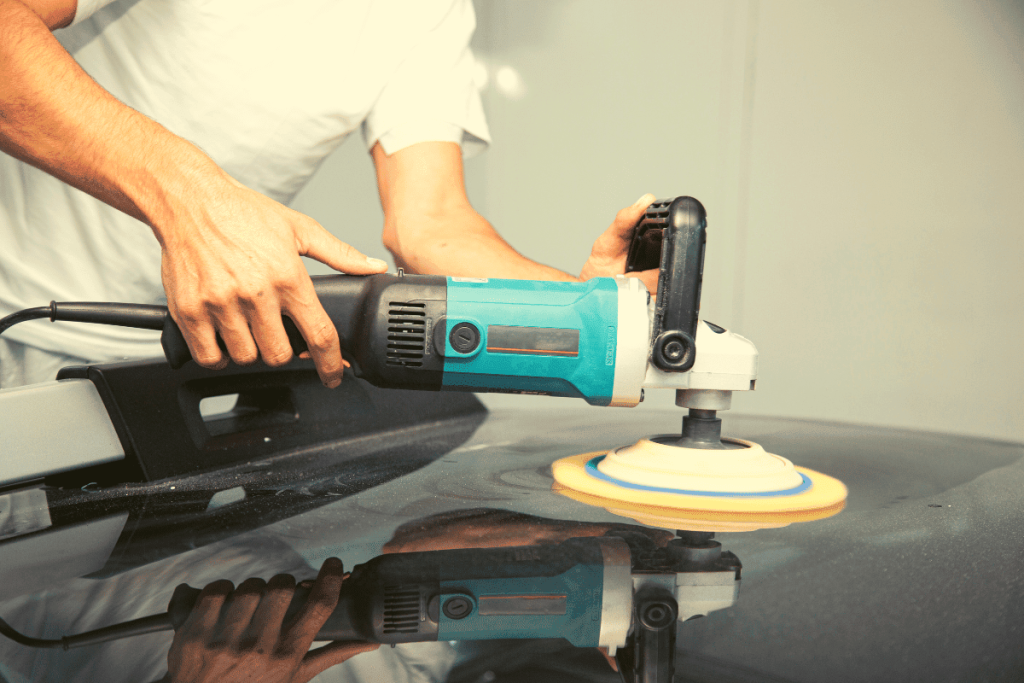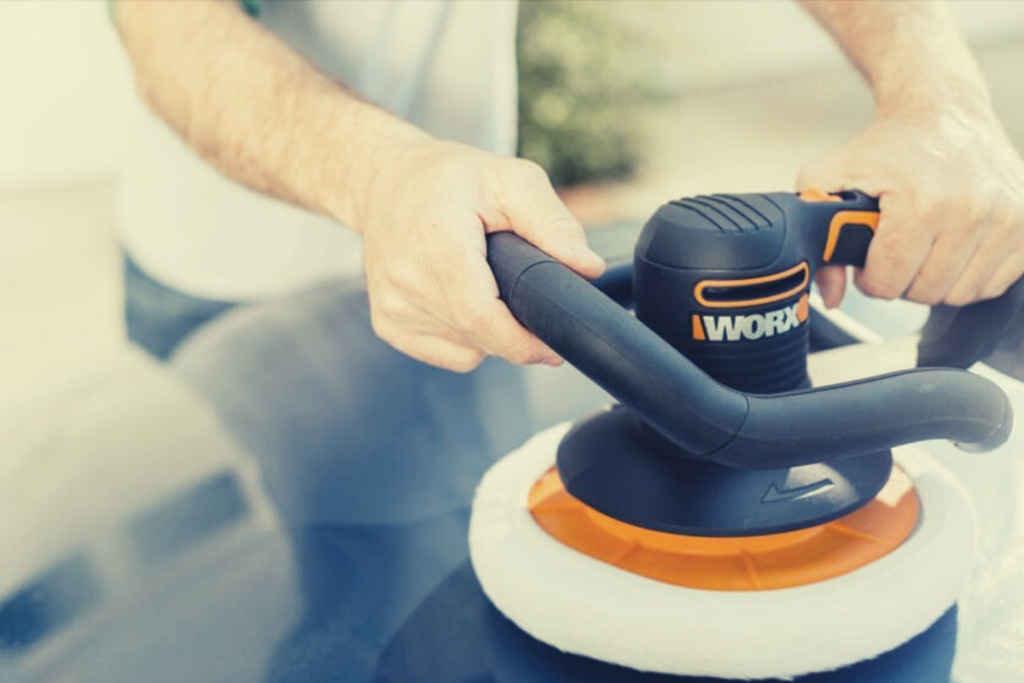As a car owner, you take pride in keeping your car looking its best. Regular maintenance, including washing and waxing, helps to protect your car’s finish from the elements. However, over time, your car’s paint may become dull, scratched, or faded. When this happens, it may be time to consider more intensive care, such as power buffing or power waxing. In this article, we will discuss the differences between power buffing and power waxing, their benefits, how they work, and how to choose the best method for your car’s finish.
What is Power Buffing?
Power buffing, also known as polishing, is a process that uses a machine with an abrasive pad to remove scratches, swirl marks, and other imperfections from a car’s paint. The machine rotates the pad at a high speed, allowing the pad to remove a thin layer of paint and restore the car’s finish.
What is Power Waxing?

The Differences between Power Buffing and Power Waxing
The main difference between power buffing and power waxing is the purpose of each process. Power buffing is designed to correct imperfections in a car’s finish, while power waxing is designed to protect and maintain a car’s finish. Power buffing removes a thin layer of paint, while power waxing adds a layer of protection.
The Benefits of Power Buffing
The benefits of power buffing include:
- Removing scratches and swirl marks
- Restoring the shine and gloss of the paint
- Preparing the surface of the car for further detailing
The Benefits of Power Waxing
The benefits of power waxing include:
- Protecting the car’s finish from the elements
- Maintaining the car’s shine and gloss
- Reducing the amount of time and effort needed to maintain the finish
How Power Buffing Works
Before power buffing, the car’s surface needs to be cleaned and prepared. This involves washing the car, removing any contaminants, and drying it thoroughly. The machine is then equipped with a pad that matches the level of imperfections on the car’s surface. A polishing compound is applied to the pad, and the machine is turned on. The machine is moved in a circular motion over the car’s surface, applying gentle pressure. The pad’s rotation removes the imperfections and polishes the paint. After buffing, the surface is wiped clean with a microfiber towel.
How Power Waxing Works
Before power waxing, the car’s surface needs to be cleaned and prepared. This involves washing the car, removing any contaminants, and drying it thoroughly. The machine is then equipped with a foam pad, and a liquid wax or sealant is applied to the pad. The machine is turned on, and the pad is moved in a circular motion over the car’s surface, applying gentle pressure. The wax or sealant is distributed evenly, creating a protective barrier over the car’s finish. After waxing, the surface is wiped clean with a microfiber towel.
When to Use Power Buffing
Power buffing is recommended when a car’s paint has deep scratches, swirl marks, or other imperfections. It’s also useful when restoring the shine and gloss of the paint. However, power buffing is a more intensive process than power waxing and should be used sparingly. Overuse of power buffing can cause damage to the paint.
When to Use Power Waxing
Power waxing is recommended as a regular maintenance step to protect and maintain the car’s finish. It can be used after washing the car, or as needed to maintain the shine and gloss of the paint.
How to Prepare Your Car for Power Buffing

How to Prepare Your Car for Power Waxing
To ensure a smooth and efficient power waxing process with a power waxer, it’s important to prepare your car’s surface. This involves washing the car thoroughly with a car wash soap and drying it thoroughly. It’s also important to remove any contaminants, such as tar or sap, with a specialized remover. Finally, mask off any areas that you don’t want to be waxed, such as rubber trim or plastic parts.
The Types of Pads Used for Power Buffing
There are several types of pads used for power buffing, including foam pads and wool pads. Foam pads are softer and gentler on the car’s finish, while wool pads are more abrasive and can remove deeper imperfections.
The Types of Pads Used for Power Waxing
There are several types of pads used for power waxing, including foam pads and microfiber pads. Foam pads are ideal for applying liquid wax or sealant, while microfiber pads are ideal for applying paste wax.
The Types of Products Used for Power Buffing
There are several types of products used for power buffing, including polishing compounds and glazes. Polishing compounds are more abrasive and can remove deeper imperfections, while glazes are gentler and can enhance the shine and gloss of the paint.
The Types of Products Used for Power Waxing
There are several types of products used for power waxing, including liquid wax and sealants, as well as paste wax. Liquid wax and sealants are easier to apply and remove than paste wax, but paste wax provides longer-lasting protection.
How to Choose Between Power Buffing and Power Waxing
The choice between power buffing and power waxing depends on the condition of your car’s finish. If your car has deep scratches, swirl marks, or other imperfections, power buffing may be necessary. If your car’s finish is in good condition but needs protection and maintenance, power waxing is recommended.
Common Mistakes to Avoid When Power Buffing
One common mistake when power buffing is applying too much pressure or using the wrong pad. This can cause damage to the paint. It’s also important to use the right polishing compound for the level of imperfections on the car’s surface.
Common Mistakes to Avoid When Power Waxing
One common mistake when power waxing is applying too much product or using the wrong pad. This can cause streaks and uneven application. It’s also important to use the right type of wax or sealant for your car’s finish.
How Long Does Power Buffing Take?
The time it takes to power buff a car depends on the condition of the car’s finish and the level of imperfections. It can take anywhere from a few hours to a full day.
How Long Does Power Waxing Take?
The time it takes to power wax a car depends on the size of the car and the type of wax or sealant used. It can take anywhere from 30 minutes to a few hours.
Can Power Buffing Damage Your Car’s Paint?
Power buffing can cause damage to the car’s paint if it’s not done correctly. Using too much pressure or the wrong type of pad or polishing compound can cause swirl marks or even burn through the clear coat.
Can Power Waxing Damage Your Car’s Paint?
Power waxing is less likely to cause damage to the car’s paint than power buffing. However, using too much product or the wrong type of pad can cause streaks or uneven application.
How Often Should You Power Buff Your Car?
Power buffing should only be done as needed to correct imperfections in the paint. Overuse of power buffing can cause damage to the paint. For most cars, power buffing should be done once a year or less.
How Often Should You Power Wax Your Car?
Power waxing should be done regularly as part of your car’s maintenance routine. Depending on the type of wax or sealant used, power waxing can last anywhere from a few months to a year. As a general rule, power waxing should be done every three to six months.
How to Maintain Your Car’s Finish After Power Buffing or Power Waxing
After power buffing or power waxing, it’s important to maintain your car’s finish to prolong the results. This includes washing the car regularly with a car wash soap, using a quick detailer to remove light contaminants, and applying a spray wax or sealant as needed to maintain the shine and protection.
Power buffing and power waxing are two methods of restoring and maintaining your car’s finish. Power buffing is more intensive and is used to correct deeper imperfections, while power waxing is a regular maintenance step to protect and enhance the shine of your car’s finish. By understanding the differences between the two methods and knowing how to properly prepare and care for your car’s finish, you can achieve the best results and prolong the life of your car’s paint.